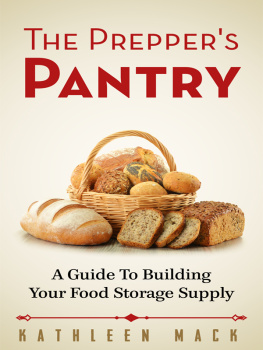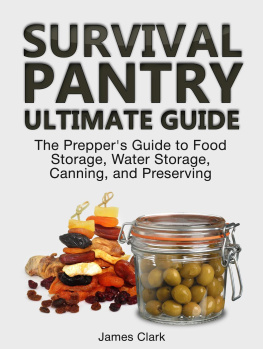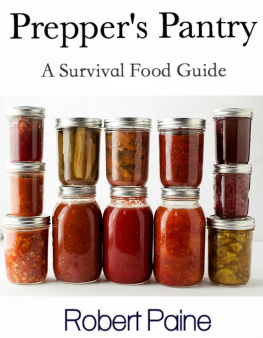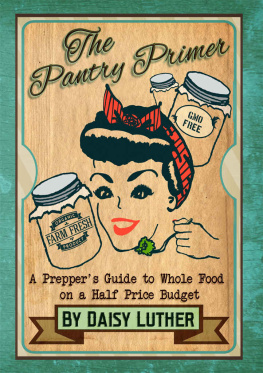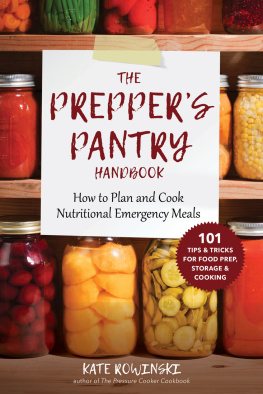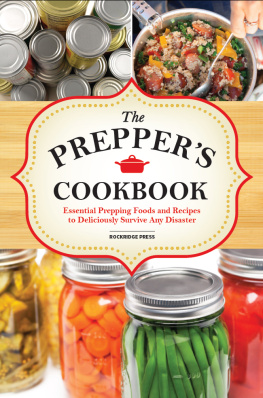

ISBN 978-1-939384-23-2
Copyright Kathleen Mack 2014
Published by Chamberton Publishing
Cover Design by humblenations
Published in the United States of America. All rights reserved under International Copyright Law. Cover and/or contents may not be reproduced without the express written permission of the publisher.
The Preppers Pantry
Building a backup food storage supply is not just for doomsday planning, its a necessary step to ensure your familys well being in the event of an emergency. Natural disasters occur around the world on a regular basis from tornados to earthquakes and everything in between. Being prepared for the unexpected is paramount to ensuring your family is taken care of. Planning ahead with the basic necessities of food and water is just the beginning. The Preppers Pantry can help guide your steps in preparing your food storage supply. From finding space in your home to setting a monthly budget for spending on your supply, this book can help get you on track and help you plan for the unexpected. Many government agencies encourage such preparedness, and taking the steps needed to help your family, extended family, and friends is not only prudent, but necessary. Waiting for help to arrive after a natural disaster or emergency may not be the best plan. Being able to care for your family and be self sufficient should be your goal.
The Preppers Pantry by Kathleen Mack can be a valuable tool in helping you get started. This book may also offer those who are well on their way to self-sufficiency some new ideas to add to their plans.
Chapter 1
Getting Started
Finding Space in Your Home
Finding space in your home for your food storage may be your first stumbling block. After all, you may look around and wonder where you would put anything extra. The cupboards and drawers are full, the closets are packed with storage and winter coats, the garage is filled with boxes and Christmas decorations, and the home office is a carved out corner in the living room with little to no space for storage. You may live in an apartment, condominium, or small house with little extra space, and fitting one more thing inside may seem impossible.
But wait believe it or not you can find space if you try!
Its time to take inventory and be creative.
First, have a look in your living room. No, you dont want cases of food stacked in the corner, or behind the sofa, but if you take a step back and look around you might find some hidden space that would work for a little food storage. Does the entertainment center have any cupboards or drawers you could clean out to make a little room? What about the end tables? The coffee table? A trunk or storage chest? Look around and be creative. Consider going through and doing a bit of spring cleaning and decide what you need to keep and what could be sold, given away, donated, or tossed. People have a tendency to save items that are not needed. This is where you must be objective and ask yourself a few important questions like, Will this space be better used for a little extra food storage or is this item able to go? Box up what can go and now youve found space where you thought none existed.
Now, move on to the kitchen. Here is where you may find even more space. Even the smallest kitchens can host a little extra space. Again, its time to be objective. Look through each cupboard. They may be stacked with extra pots and pans, juicers, blenders, pitchers, plastic bowls, and holiday dishes. All of these items take up space and many of these items are really not that necessary. Ask yourself some important questions. Do I really need the juicer? Do I use it? Do these old plastic bowls ever get used? If so, keep what you actually use and consider boxing up the rest. Broken pans, multiples of the same sized pots, extra skillets, drawers of knick knacks and what-nots, all take up valuable space. The old thought of, What if I need this someday? may creep in, but remind yourself that if you havent used it in a while, or ever, its probably not needed. Remember, youre looking for space, not stuff to keep. After you box up the extra bowls, pots, pans, plastics, dishes, and pitchers you may be surprised at how much space youve found.
Next, its time to move into the bedrooms. Before you pull the brakes and say, I dont want food in my bedroom! Ask yourself these questions: if it isnt visible and doesnat get in the way is it really a big deal? Chances are the answer is no. Honestly, you may find more space here than you initially thought. Clean out under the bed and youll see lots of free space. The closet, even if its small, may offer a little space, and even an extra dresser may have a few drawers that arent really used. The key here is to be organized, keep what you use and what you need, and box up everything else. After youve done a bit of clearing out, you may even feel better about what you decide to keep. Knowing whats important versus whats clutter is a big step in getting organized, too. Now you can consolidate items and free up a nice block of space for your food storage. And the nice part about it is that it wont be in the way, and its not readily visible.
The childrens rooms may be next on your list now. If so, then go through and see what you think. Depending on the ages of your children and taking all safety precautions into consideration, decide if these rooms would be suitable for a little extra food storage. If not, then its time to move on to another room. After all, your familys safety is paramount to everything else.
The laundry room, home office, spare bedroom, basement, or mudroom may be next on your list of rooms to find storage space in. These extra rooms can host a ton of space to be creative with. Adding bookshelves, storage bins, or stackable units would be a plus, and offer a nice way to organize your food storage. Turning a portion of one of these rooms onto a designated pantry would be ideal and help you maintain your supply. Consider purchasing storage units, shelving, or bins from a thrift store for a cost effective way to stack and categorize your food. You can even buy metal shelving units with doors that close so the food is out of sight and not cluttered looking. Old shelves can be painted and stenciled to add a touch of dcor to any of these spaces.
The garage may not be a suitable option for your food storage as many garages are not air conditioned. One of the essentials of storing food properly and safely is keeping the room temperature cool. So, unless your garage is air conditioned, or you live in an area where the temperature rarely rises above 72 degrees, then skip this space and move on.
Storage closets, hall closets, hall cupboards, and linen closets can also hold valuable space to use. Consider hall closet space and determine if the items stored in there could be moved to another closet. Winter coats, umbrellas, unused items, and vacuum cleaners can be relocated to other places. This space is a great place to begin your pantry, too. Adding built in shelves that are the depth of the closet will afford much new space and hold more food than you think. Try adding shelves from the very top to the bottom, leaving a bit of space for cases of food, larger items, or tall containers. Your hall closet can easily transform into your new Preppers Pantry. Also, consider scaling back the items in your linen closet, or moving them to the bathroom, bedrooms, bedroom closets, or garage. Consider boxing up what you dont need and donating them to a thrift store or to charity. The key here is to continually be on the lookout for space, and its nice to help others in the process. The more space you free up, the more food you can store, and the more you build your food preparedness pantry.
Next page
